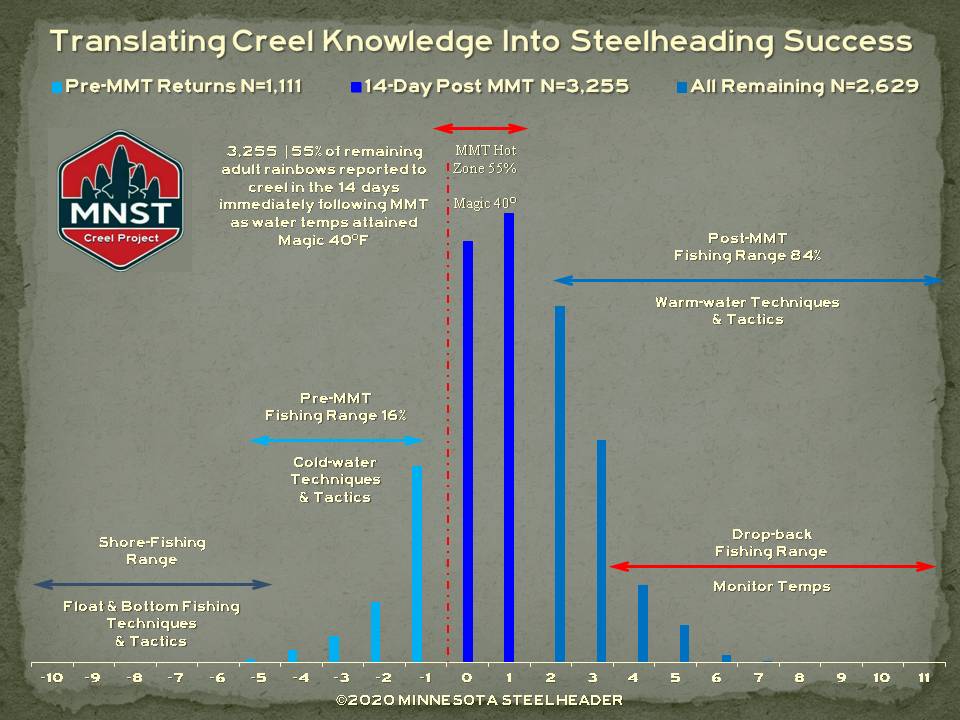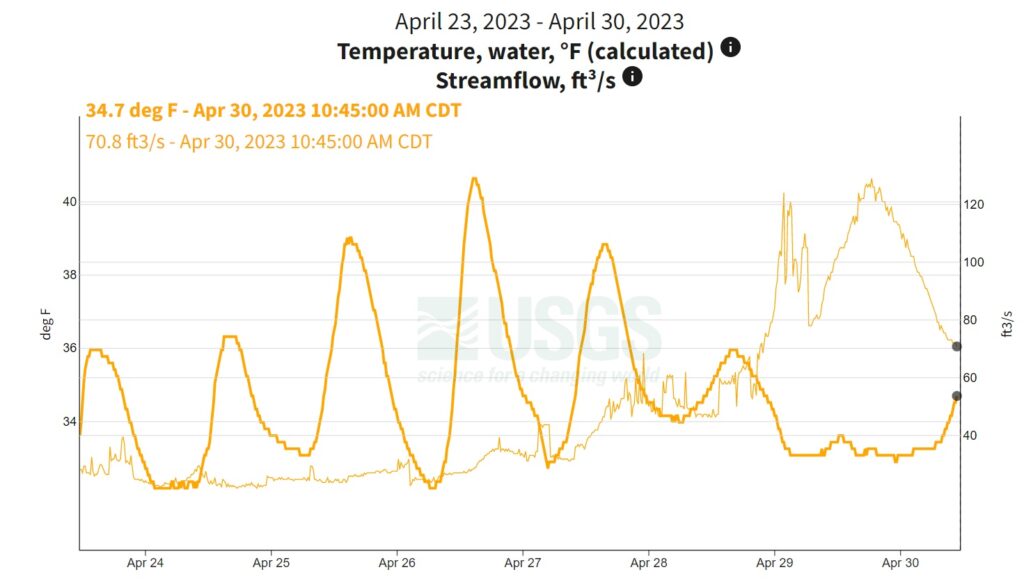Minnesota Steelheader spends a lot of time discussing what we call Magic 40°F, and there are so many reasons why. Magic 40°F is a simple way to define both the the science as well as a range of more complex steelheading principles. Once you understand it, the science and the art of steelheading on the North Shore merge allowing you to quickly determine when, where and how to fish.
Magic 40°F, What is it?
Based on Minnesota DNR investigational reports, trap and creel data, the simplified threshold for significant migration of up-bound adult steelhead occurs when average daily stream temperatures reach 38°F, and daily high stream temperatures exceed 40°F. MNST defines this two-part equation as, “Major Migration Threshold” or MMT. DNR fisheries literature for the North Shore discusses this phenomenon although they don’t use the term MNST has adopted to illustrate this important concept.
Please note MNST is not suggesting there is single migration starting point based on one specific stream temperature. We’re talking about numbers and movement of steelhead that are numerically and statistically greater than at any other time in the run.
Up-bound migration of steelhead does in fact begin prior to the MMT threshold as ice recedes and streams become navigable to the fish. We know from both MNST Creel Project as well as DNR Fisheries Trap and creel data that approximately 15% of steelhead return to creel and trap prior to MMT occurring. Once MMT is attained however, all available data demonstrates that high numbers of adult steelhead, 85-90%+/- return over the next 4-7 weeks. Of all the steelhead returning within that 4-7 week period, ~55% have returned to MNST creel (been caught and reported) within the 14 days immediately following MMT. DNR reports show 54% of steelhead returning to trap within the same time-frame.
Magic 40°F is a simple statement that combines the fisheries science behind MMT with the techniques, tactics and presentations to use. It’s a roadmap for catching steelhead during each distinct range or phase of the run. Bear with us as we try to connect the dots…
Below are two interesting tables with information taken from 2007-2011 spring DNR creel surveys. The first shows the average number of hours required to catch a steelhead on 15 North Shore rivers by Region. The list is sorted by hours with the overall average hours for all rivers listed at the bottom. While French River and McQuade Harbor are listed in the table, the number of hours (46 & 61) were not used to calculate total average hours since fishing is only allowed outside the mouth of the river in the lake.
| River | Hours |
|---|---|
| Mid-Shore 1 | 3 |
| Upper-Shore 1 | 3 |
| Upper-Shore 2 | 3 |
| Upper-Shore 3 | 4 |
| Upper-Shore 4 | 4 |
| Mid-Shore 2 | 5 |
| Mid-Shore 3 | 5 |
| Lower-Shore 1 | 6 |
| Mid-Shore 4 | 6 |
| Upper-Shore 5 | 6 |
| Mid-Shore 5 | 7 |
| Upper-Shore 6 | 8 |
| Upper-Shore 7 | 9 |
| Lower-Shore 2 | 11 |
| Lower-Shore 3 | 17 |
| *French (Lake only) | 46 |
| *McQuade Harbor (Lake Only) | 61 |
| Rivers: 15 | Average Hours: 6.4 |
The second table shows the percentage of steelhead caught by temperature range over the same 5 years of surveys.
| Temperature Range | Steelhead Caught |
|---|---|
| 32-34°F | 4% |
| 35-39°F | 13% |
| 40-49°F | 54% |
| 50-55°F | 20% |
| 55-65°F | 9% |
MNST Creel Project (MNST-CP) numbers closely reflect the DNR Creel Survey numbers. Compare the DNR’s steelhead catch percentages at 32-39°F of 17% (4+13%) with MNST Pre-MMT Fishing catch percentages of 16%. Next, look at what happens when stream temperatures hit Magic 40°F. DNR: 54% of steelhead caught at 40-49°F. MNST: 55% of steelhead caught at 40-49°F.
It’s hard to visualize what is going on simply by looking at the raw data. It’s even more difficult to apply it to steelhead fishing on the North Shore if you don’t realize the connection.
MNST has made numerous attempts at blending the science and the art over 14 years of the MNST-CP, the chart below is a visual representation. Each fishing range listed can essentially be broken down by water temperature. If you haven’t heard it from us before, carry a thermometer. Better yet, carry two:
- Shore-Fishing Range: No stream temp range given as streams are frozen and inaccessible to migrating fish, this range specifically refers to fishing in Lake Superior. You can treat it as <=32°F
- Pre-MMT Fishing Range: 32-39°F. As noted, cold-water techniques and tactics will be critical to success while fishing in this range. Selecting the proper fishing location based on stream feature types in any given stream is key to being successful in this range.
- MMT Hot Zone or Magic 40°F: Initially 40-45°F, but water temps may climb into the 50’s°F towards the end of the period. The highest percentage of adult steelhead in any given run year begin upstream migration in this range, and most steelhead will spawn in this range. Most presentations will work in the MMT Hot Zone although you need to consider current conditions such as flow, as well as fishing locations within a stream
- Post-MMT Fishing Range: 45-60°F+. Early in this range, new pushes of fresh fish will come during increases in flow caused by precipitation. Spawning begins tapering off, and fish will feed heavily as they begin backing out of the rivers to return to the lake. Avoid hooking mortality by monitoring stream temps, and fishing early or late in the day as stream temps approach 60°F. Consider not fishing at all if stream temps are above 64-65°F.

The art of steelheading encompasses all of the different techniques, tactics and presentation you use based on specific stream temperature ranges, flow levels and water clarity. Selecting a stream to fish, or the location within a stream to fish, is dependent on those same environmental variables. The science of steelheading really boils down to the following:
- Steelhead are ectothermic. It’s a fancy way of saying they are cold-blooded. The body temperature of steelhead is usually very close to the temperature of the surrounding water, and steelhead are dramatically affected by temperature fluctuations
- By the same token, water temperature generally determines what steelhead are doing, where they are doing it, and when they are doing it
- It’s critical to carry a thermometer because stream temperatures tend to fluctuate widely throughout the day, particularly during the runup to Magic 40°F and MMT. Steelhead will adjust locations and activity accordingly. See example below. The bold line plots USGS daily temp readings taken at 15-minute intervals on an Upper Shore stream

So what happens when we match the stream temp ranges (Science) to the Fishing Ranges (Art) depicted in the chart?
| Temperature Range | Steelhead Caught |
|---|---|
| Pre-MMT 32-34°F | 4% |
| Pre-MMT 35-39°F | 13% |
| MMT Hot Zone 40-49°F “Magic 40°F” | 54% |
| Post-MMT 50-55°F | 20% |
| Post-MMT 55-65°F | 9% |
There are nearly 7,000 fish samples represented in the chart above. The taller the bar, the greater the number of fish sampled. MNST built the art into the chart based on the science; steelhead have confirmed it in overwhelming numbers. Get a stream temperature, then use the chart to determine how you are going to approach steelheading for the day. Continue to take temp measurements and adjust accordingly. Apply the art using the appropriate techniques and tactics for each range and you will be a successful steelheader.
